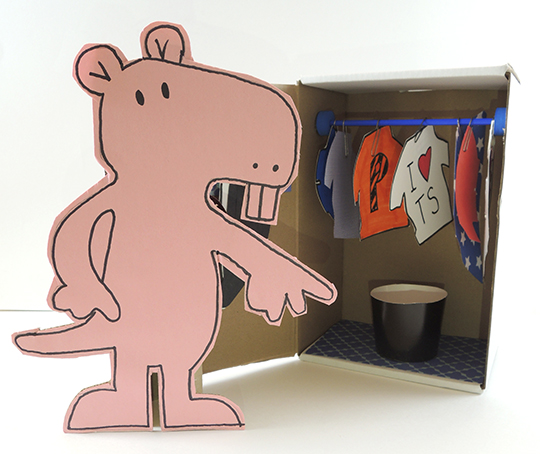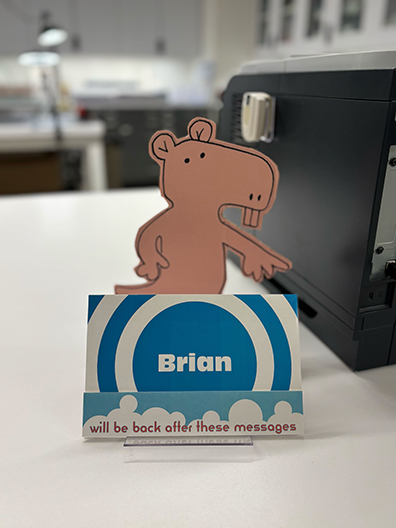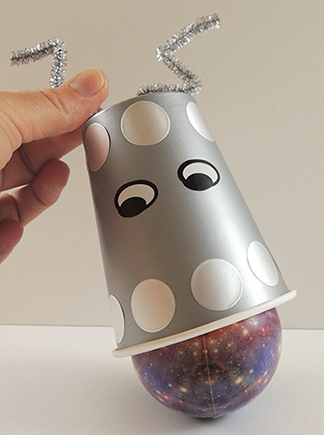
Happy New Year! It’s 2025, and resolutions abound! If one of those resolutions involves a new fashion direction, well, today’s post is very relevant. ESPECIALLY if you are a naked mole rat seeking a plethora of new looks!
We read Naked Mole Rat Gets Dressed by Mo Willems (Hyperion, 2009). Wilbur is a naked mole rat who likes clothes. Unfortunately his passion for fashion is ceaselessly mocked and questioned by the other naked mole rats. Especially when Wilbur opens a clothing store. Outraged, the naked mole rats march Wilbur to Grand-pah mole rat for a supreme talking to. But wise Grand-pah has nothing but words of encouragement for Wilbur (and all the other naked mole rats) to lean into their individualism and follow their fancies.
You’ll need:
The simplest form of this project is to print the mole rat and clothing templates, then color and cut them out. Attach two button magnets to the mole rat, then tape paper clips on the backs of the clothing. Connect the paperclips to the magnets to change outfits!
 At our story time, however, we went with a sturdier mole rat that could stand on its own. First, we traced our mole rat templates onto pink construction paper, then backed them with corrugated cardboard. We added a toilet paper tube support to the back, and then finished by attaching the clothing magnets. Here’s a look at the back and the front of our finished mole rats:
At our story time, however, we went with a sturdier mole rat that could stand on its own. First, we traced our mole rat templates onto pink construction paper, then backed them with corrugated cardboard. We added a toilet paper tube support to the back, and then finished by attaching the clothing magnets. Here’s a look at the back and the front of our finished mole rats:
 We also decided we needed to be extra fancy and make our mole rat a closet. As you can see, the closet rack is a snippet of balloon stick secures with two foam beads. Dangling from the rack are paper clips that act as “hangers” for the shirts, skirts, and pants. There’s a shortened paper cup glued to the floor to house all the fashion accessories, and mini clothespins hot glued to the door to secure the mole rat’s various hats.
We also decided we needed to be extra fancy and make our mole rat a closet. As you can see, the closet rack is a snippet of balloon stick secures with two foam beads. Dangling from the rack are paper clips that act as “hangers” for the shirts, skirts, and pants. There’s a shortened paper cup glued to the floor to house all the fashion accessories, and mini clothespins hot glued to the door to secure the mole rat’s various hats.
 Kids loved customizing the various outfits and hats!
Kids loved customizing the various outfits and hats!
This slideshow requires JavaScript.
Sometimes, kids really connect with a project, and one mom reported that her son’s naked mole rat was his constant companion for WEEKS. He went with her son to the gym, on trips, to restaurants, in the stroller, was cuddled at night, and basically lived the life of a most beloved friend. Mom reports that this lead to some very interesting questions from onlookers about naked mole rats, which her son was happy to answer.
But that’s not all! Another one of our naked mole rats caught the eye of Brian George, Preparator in Special Collections. It still stands in his office to this day!

 Have a reluctant reader who might appreciate good race? This simple project will get them raring to read letters and words with the assistance of their own personal reading robot! Built out of things in your home or office, it’s low tech, but high levels of F-U-N!
Have a reluctant reader who might appreciate good race? This simple project will get them raring to read letters and words with the assistance of their own personal reading robot! Built out of things in your home or office, it’s low tech, but high levels of F-U-N! Next, write alphabet letters on Post-it notes and stick them to a tabletop. Have the reader and their robot sit on the opposite side of the table. As you call out the letter, they can slide and release their robot towards the proper Post-it!
Next, write alphabet letters on Post-it notes and stick them to a tabletop. Have the reader and their robot sit on the opposite side of the table. As you call out the letter, they can slide and release their robot towards the proper Post-it!

 Our unicorn is the stick horse we designed for this
Our unicorn is the stick horse we designed for this 


 At our story time, however, we went with a sturdier mole rat that could stand on its own. First, we traced our mole rat templates onto pink construction paper, then backed them with corrugated cardboard. We added a toilet paper tube support to the back, and then finished by attaching the clothing magnets. Here’s a look at the back and the front of our finished mole rats:
At our story time, however, we went with a sturdier mole rat that could stand on its own. First, we traced our mole rat templates onto pink construction paper, then backed them with corrugated cardboard. We added a toilet paper tube support to the back, and then finished by attaching the clothing magnets. Here’s a look at the back and the front of our finished mole rats: We also decided we needed to be extra fancy and make our mole rat a closet. As you can see, the closet rack is a snippet of
We also decided we needed to be extra fancy and make our mole rat a closet. As you can see, the closet rack is a snippet of  Kids loved customizing the various outfits and hats!
Kids loved customizing the various outfits and hats!